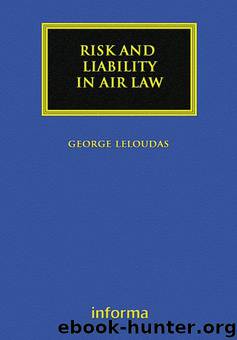Risk and Liability in Air Law by George Leloudas

Author:George Leloudas [George Leloudas]
Language: eng
Format: epub
Publisher: Informa
5.52 The SCt in the Saks case seems to have gone a step further than the French definition of the term “accident”.53 However, it did not exceed the plain meaning of the term and the French text of the Convention. Instead, the SCt moved within the confines of the dictionary definition and made a distinction that corresponds to the plain meaning of the word in English.
5.53 The definition of “accident” promulgated in Saks has received acceptance by Courts worldwide. Especially in the UK, it has been unanimously upheld by the English Court of Appeal in Chaudhari v. British Airways54 and in Barclay,55 and by the HL in Morris and in Re DVT. In Chaudhari, Leggatt LJ endorsed the “careful analysis” of O’Connor J in Saks and held that “in principle, ‘accident’ is not to be construed as including any injuries caused by the passenger’s particular, personal or peculiar reaction to the normal operation of the aircraft”.56 In Morris, Lord Hope held that the interpretation of Article 17 in Saks “gives the word ‘accident’ a natural and sensible meaning in the context of Article 17, and I too would adopt this approach”.57
5.54 In Re DVT, their Lordships were unanimous in holding that an “accident” must be an unexpected event, external to the passenger and occurring during carriage. Lord Scott noted that “Article 17 distinguishes between the bodily injury on the one hand and the ‘accident’ which was the cause of the bodily injury on the other”.58 His Lordship cited with approval Saks and further held that “an event or happening which is no more than the normal operation of the aircraft in normal conditions cannot constitute an Article 17 ‘accident’ and … the event or happening that has caused the damage of which complaint is made must be something external to the passenger”.59 Furthermore, Lord Mance supported the observation of counsel for the defendant that “the word ‘flexibly’ used by the Supreme Court [in Saks] does not … necessarily equate with ‘broadly”’.60
5.55 The agreement of the courts is to demonstrate that the definition in Saks created a balance between the interests of passengers and carriers in accordance with the drafting spirit of the WC and the plain meaning of the term. Most importantly, the SCt in Saks managed to create a protective legal cocoon around carriers which were facing a significant increase in their legal exposures at the beginning of the risk era. It is true that a narrower definition might have been in greater accordance with the risk environment in the 1920s when the original Convention was drafted.
5.56 At the same time, this narrow definition would have meant that social risk perceptions would be repressed. If one takes into consideration the disintegrated state of the WCS in the 1970s and 1980s, and the changing social conditions, it is easy to come to the conclusion that a narrow definition would have “exclude[d] the application of the Convention”, with domestic laws filling the gap.61
5.57 The threat that a narrow definition might have
Download
This site does not store any files on its server. We only index and link to content provided by other sites. Please contact the content providers to delete copyright contents if any and email us, we'll remove relevant links or contents immediately.
The Thirst by Nesbo Jo(6778)
Permanent Record by Edward Snowden(5705)
The Myth of the Strong Leader by Archie Brown(5390)
Spare by Prince Harry The Duke of Sussex(5023)
A Higher Loyalty: Truth, Lies, and Leadership by James Comey(4813)
Secrecy World by Jake Bernstein(4608)
Adulting by Kelly Williams Brown(4458)
The Borden Murders by Sarah Miller(4210)
Machine Learning at Scale with H2O by Gregory Keys | David Whiting(4017)
Killers of the Flower Moon by David Grann(3917)
American Kingpin by Nick Bilton(3730)
Fear by Bob Woodward(3605)
The Secret Barrister by The Secret Barrister(3587)
Future Crimes by Marc Goodman(3482)
The Last Girl by Nadia Murad(3414)
The House on Mango Street by Sandra Cisneros(3370)
Liar's Poker by Michael Lewis(3340)
The Social Psychology of Inequality by Unknown(2916)
Graduate Admissions Essays, Fourth Edition: Write Your Way into the Graduate School of Your Choice (Graduate Admissions Essays: Write Your Way Into the) by Asher Donald(2848)
